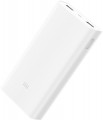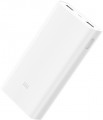Battery type
The type of own batteries installed in the power bank.
Lithium-ion(Li-Ion) or
lithium-polymer(Li-Pol) batteries are most commonly used today. Other options are less common — solutions based on
nickel-metal hydride(Ni-Mh) batteries, as well as on LiFePO4 type cells. In addition, a rather promising development has appeared relatively recently — graphene batteries; however, as of early 2021, they are just beginning to be introduced into mass production. Here are the main features of each of these varieties:
— Li-Ion. Lithium-ion technology allows you to create quite capacious batteries of small dimensions and weight. In addition, such elements are easy to use (the main operating parameters are regulated by the built-in controller), have a high charge speed and are practically not affected by the "memory effect" (reduction in capacity when charging an incompletely discharged battery). The main disadvantage of lithium-ion batteries is a rather narrow range of permissible ambient temperatures. This is not a problem in urban usage, when the power bank is used mainly indoors and is carried in a pocket or in a bag; but for less favorable conditions (such as long hikes in the cold season), it is worth choosing models with good thermal insulation. You can also find information that lithium-ion batteries are prone to fires and even explosions; however, this is usually due to
...failures in the embedded controllers, and these controllers are also constantly being improved, and nowadays the risk of such an accident is so low that it can actually be neglected.
— Li-pol. Further development and improvement of the lithium-ion technology described above; the main difference is the use of a solid polymer electrolyte instead of a liquid one (hence the name). This made it possible to achieve even greater capacity without increasing the dimensions, as well as to reduce the potential for fires and explosions during abnormal operation. On the other hand, lithium-polymer batteries are somewhat more expensive than lithium-ion batteries and are even more sensitive to temperature disturbances.
— Ni-Mh. Nickel-metal hydride batteries are distinguished by their reliability and a wide range of permissible temperatures, however, with the same dimensions, they are inferior in capacity to lithium-ion (and even more to lithium-polymer) batteries, and they also require certain specific operating rules to be observed. In addition, it is worth noting that Ni-Mh technology is well suited for removable batteries. It is in this format that such batteries are most often used: power banks of the Ni-Mh format are usually adapters with slots for several replaceable elements of a standard size (for example, AA). In this case, usually, several corresponding removable batteries are included in the kit, however, if desired, they can be replaced with other elements — these can even be disposable batteries from the nearest store. Such an opportunity can turn out to be very useful if the power bank is out of juice at an unfortunate moment, but there is no way to charge it; in addition, worn-out batteries can be replaced with fresh ones without changing the entire device.
— Li-FePO4. Another modified version of the Li-Ion batteries described above, the so-called "lithium iron phosphate". The advantages of such cells over classical lithium-ion ones are, first of all, a stable discharge voltage (until the energy is exhausted), high peak power, long service life, resistance to low temperatures, stability and safety. In addition, due to the use of iron instead of cobalt, such batteries are also safer to manufacture and easier to dispose of. At the same time, they are noticeably inferior to the classic lithium-ion ones in terms of capacity, and they are more expensive, which is why they are rarely used.
— Graphene. Batteries based on graphene — a carbon film one atom thick. The battery itself consists of a set of such films, between which silicon plates are laid, and lithium cobaltate or magnesium oxide is used as an anode. This design provides a number of advantages over the earlier batteries described above. First, graphene technology provides a high charge density, which allows you to create capacious and at the same time light and compact batteries. Secondly, for the production of such batteries, fewer rare resources are needed than for the same lithium ones; and the production itself is more environmentally friendly. Thirdly, such batteries are not prone to overheating and explosions when overloaded or damaged. On the other hand, graphene power supplies take a long time to charge and are not durable. However, this technology is still developing, and in the future it is likely that these shortcomings will be eliminated — completely or at least partially.Power output (all ports)
The total charge power provided by the power bank on all connectors overnight - when devices are connected simultaneously to all charging ports.
This parameter is given due to the fact that the total charge power does not always correspond to the sum of the maximum powers of all available ports. The built-in battery of a power bank often has its own limitation on the output power. Therefore, for example, in a model with two 18 W USB ports, each total charge power can be the same 18 W. Note that the distribution of power among the connectors may be different: in some models it is divided equally, in others it is divided in proportion to the maximum current strength (if it differs on different ports). These nuances should be clarified using the detailed characteristics of the charging connectors.
If you plan to regularly use all power bank connectors at once, you should pay attention to this indicator.
Full charge time
The time required to fully charge a battery discharged “to zero”. Features of the charging process in different models may be different, respectively, and the time required for this may differ markedly even with the same capacity.
Fast-charging batteries tend to be more expensive. Therefore, choosing this option makes sense if you do not have much time to replenish your energy supply — for example, for hiking. However, keep in mind that charging at full speed may require a charger that supports certain fast charging technologies (see below).
It must also be said that in most modern batteries, the charging speed is uneven — it is highest at the several first percent from zero, then gradually decreases. Therefore, the time required to replenish the energy supply by a certain percentage will not be strictly proportional to the total claimed charge time; moreover, this time will depend on how much the battery is already charged at the time the procedure starts. For example, charging from 0 to 50% will take less time than from 50 to 100%, although both there and there we are talking about half the capacity.
Low current charging
Low current charging allows you to seamlessly charge devices that do not require high current. This allows you to extend the life cycle of the devices and protect them as much as possible during charging. Such devices include smartwatches, headphones, headsets, etc.
Manual voltage switch
A regulator that allows you to change the voltage at the output of the power bank manually. Most often, a
manual voltage switch is used to set the parameters on the DC output. This is due to the fact that this type of output does not have a strictly defined standard voltage, and different devices may need a different number of volts. So if you plan to use a power bank with several DC-charged gadgets at once (for example, laptops), most likely, a model with this feature will be the best choice.
Note that models without DC connectors may have a manual regulator to change the maximum current on the USB outputs; for such devices, the presence of a voltage switch is also indicated, but the notes specify if the current is meant.

